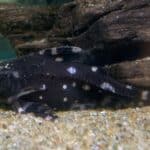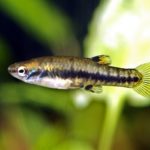The Spotted Gar, which you might also hear referred to as Lepisosteus oculatus, is a North American freshwater fish that lives in rivers and lakes.
Lepisosteus oculatus is a predator, and in most lakes and rivers, it’s at the top of the food chain, or at least very close to it.

The Spotted Gar is known for its long, spotted body and its wickedly sharp teeth, but there’s much more to learn about this river-dwelling species, especially if you’re planning to keep one in an aquarium.
Below is a complete care guide for the Spotted Gar, including the best tank size, compatible tank mates, and the optimal diet.
Care Guide
Tank Size
The Spotted Gar is not a fish that’s easily kept in a home aquarium. This is, partially, due to the fact that Spotted Gars can grow to very large sizes, making them physically incompatible with most non-commercial tanks.
Spotted Gars can grow up to 3 feet in length, which means that when you factor in how much room they need to move around comfortably, you’re looking at a very large aquarium.
Most experts would recommend something in the region of 500 or 600 gallons. Even though you may introduce a Spotted Gar into an aquarium before it reaches its adult size, you should still ensure that the tank will be large enough to accommodate it long-term.
Aquariums of the size required to house an adult Spotted Gar are not readily available through popular retailers.
Tank Mates
Because Spotted Gars are so often apex predators in aquatic environments, you will need to think very carefully before introducing any potential tank mates.
If you choose to create an inter-species aquarium, you should ensure that any tank mates are roughly the same size as the Spotted Gar. The Spotted Gar will not typically be aggressive towards fish of a similar size.
Therefore, larger catfish species, polypterus, and bichirs are often the best choices to accompany the Spotted Gar.
Care should be taken to introduce different fish species at similar ages and at the same time. This will reduce the possibility of territorial behavior when a new species is introduced.
Same Species Tanks
You can keep several Spotted Gars together in the same tank, or even keep a Spotted Gar in an aquarium with other Gar species, as long as their sizes line up.
However, the first thing to be aware of if you’re planning to do this (and this also applies to introducing other tank mates) is that you’ll need an even larger tank, which simply isn’t feasible unless you’re a commercial fish keeper.
If you’re not looking to become a Spotted Gar breeder, you will need to keep only one sex in your aquarium. Luckily, Spotted Gars are not actually highly aggressive in terms of their temperament (they are simply eating machines when it comes to smaller fish), so whether you keep 2 males or 2 females together shouldn’t make too much of a difference in terms of dynamics.
Water Parameters
Spotted Gars thrive in water temperatures between 53.6 and 68 degrees Fahrenheit, with a pH that comfortably sits between 6.5 and 8.
The water hardness should be kept between 9 and 19.
However, it is worth noting that Spotted Gars, like other Gar species, are very tolerant of various water conditions.
This doesn’t mean you should disregard the information outlined above, but it means you don’t have to panic if, for example, the oxygen level in your Gar’s tank drops. Gars have resilient and highly functional swim bladders, so they’ll be able to tolerate this until you can rectify the situation.
What To Put In Their Tank
You should make sure that the substrate you put at the bottom of your Spotted Gar’s aquarium is organic and formed of clay and silt. This is the type of substrate that Gars prefer in the wild.
We also recommend setting up an aquarium with plenty of vegetation so that your Spotted Gar can engage in its usual foraging behaviors, as it would do in its natural habitat.
To make your Spotted Gar comfortable, this vegetation should be dense enough to allow for camouflage, which is the method Spotted Gars use in the wild to ambush their prey and hide from other predators who might be larger than them.
Common Diseases
The diseases that can plague the Spotted Gar are the same ailments that affect many other Gar species.
Spotted Gar are susceptible to skin diseases such as White Spot Disease as well as any parasitic infections that might typically infect freshwater fish.
In addition to diseases that the Spotted Gar itself might suffer from, it’s important to take note of some of the diseases that may be transmitted from Gar to humans.
For instance, the main reason Gars do not form part of the human diet is the fact that they can transmit an illness known as Histamine Fish Poisoning, which can produce symptoms such as flushed skin and heart palpitations.
Food & Diet
As an aquatic predator, the Spotted Gar requires a diet of (ideally fresh) fish and other water-dwelling animals to survive and thrive.
When your Spotted Gar is still a juvenile, it’s best to feed it a diet of small fish such as minnows. As they grow into adulthood, Spotted Gars can start to eat larger fish – especially shad.
Spotted Gars particularly enjoy crustaceans such as crayfish, and some studies have shown that the crayfish actually makes up most of their diet in the wild. Crabs and shrimp are also a common diet staple for the Spotted Gar.
Where possible, you should try to feed your Spotted Gar live food to mimic the reality of their natural environment.
Lifespan
The Spotted Gar has a very long lifespan for a freshwater fish. Spotted Gars frequently live up to 18 years, and a 2-decade lifespan is not at all unusual.
In addition to the large size of the Spotted Gar, its long lifespan is a reason to think very carefully about bringing a Spotted Gar into your home. You will need to be prepared to care for your Spotted Gar for the best part of 20 years.
Appearance
You’ll definitely know a Spotted Gar when you see one. This fish species is hard to miss when you know what to look for.
Spotted Gars have elongated bodies, which can be described as dart-shaped, and beak-like mouths filled with needle-sharp teeth. The head, body, and fins are covered with dark spots on thick scales shaped like diamonds.
Size
Compared to other species of Garfish, such as the Alligator Gar, the Spotted Gar is actually relatively small. However, that doesn’t mean the Spotted Gar isn’t impressive in its own right when it comes to size.
The Spotted Gar typically grows between 2 and 3 feet long, and the average weight is between 4 and 6 feet.
Behavior & Temperament
Many people mistakenly believe that because Spotted Gars are such voracious predators and because they are, overall, a large fish species, that they are naturally aggressive. Actually, this isn’t the case.
Spotted Gars certainly exhibit aggressive behavior when attacking prey due to their natural predatory instincts. However, when surrounded by fish that are either the same size or larger, the Spotted Gar can actually behave quite peacefully, with semi-aggressive behavior marking the upper limit of their temperament.
Breeding
Female Spotted Gars reach sexual maturity at about 3 or 4 years old. Once sexual maturity has been reached and breeding season (February to June) comes around, the female will spawn in slow-flowing, shallow water, with lots of protective vegetation. The female can produce about 20,000 eggs at one time.
At this point, multiple sexually mature males will approach and attempt to court the female. This involves competing with one another to fertilize the eggs.
Once the eggs have been fertilized, they take approximately 10 to 14 days to hatch into fry. There is no parental care for the eggs prior to or after hatching, however. Instead, the eggs adhere to vegetation in the area for protection and camouflage.
Breeding Spotted Gar in an aquarium environment is a challenging task, not only because of lack of space but because Spotted Gars are not typically as eager to mate with one another as some other fish species.
Gender Differences: Male vs. Female
The body of the female Spotted Gar is usually more elongated than that of the male Spotted Gar. Additionally, the female snout tends to be significantly longer, although researchers have not yet confirmed why this might be.
Fun Facts
- The first half of the binomial nomenclature for the Spotted Gar (Lepisosteus) is derived from the Greek language and translates, in English, to ‘bony scale’. This is a reference to the diamond-shaped, armor-like scales on the Spotted Gar’s head and body.
- Spotted Gars are able to use their swim bladders to make themselves float at the top of the water like sticks. This helps them to cleverly ambush their prey.








